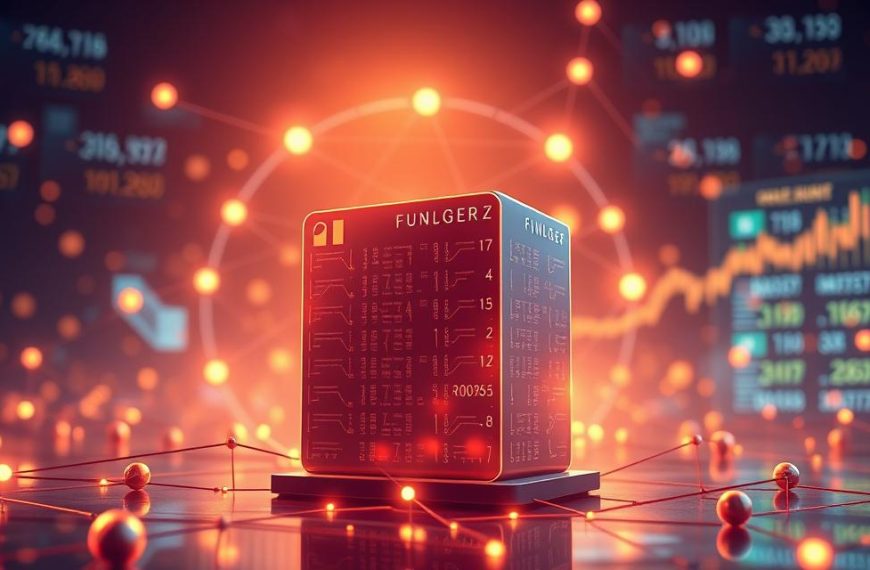The world of cryptocurrency is changing fast. Next-generation cryptocurrency projects are making blockchain technology better. They focus on being fast, using less energy, and being useful in real life.
Platforms like Solana show this change. They can handle 65,000 transactions per second. Ethereum 2.0 is also changing, moving to proof-of-stake to save energy and fix slow speeds.
This isn’t just about making things work better. It’s about changing the market. The 2024 crypto trends will highlight projects that solve real problems. These include making different blockchains work together and following rules.
Experts look at two things: how well a project works and how many people use it. How much money it makes is also important.
We’ll look at the top contenders. We’ll see how they mix new ideas with things that work. This is what makes a project valuable in the digital finance world.
The Evolution of Cryptocurrency Technology
Blockchain has grown from a small digital project to a $2.9 trillion market. This growth shows how innovation solves problems and opens new doors for decentralised systems.
From Digital Gold to Programmable Money: Three Generations of Blockchain
First-generation blockchains, like Bitcoin, focused on being secure but not flexible. They set the stage for digital gold with proof-of-work. The second generation, led by Ethereum, brought smart contracts. These contracts enable DeFi ecosystems.
Third-generation networks take a more complete approach:
- They have multi-layered architectures for better performance
- They use energy-efficient methods like proof-of-stake
- They allow for communication between different blockchains
| Feature | First Generation | Second Generation | Third Generation |
|---|---|---|---|
| Primary Focus | Store of value | Smart contracts | Scalable ecosystems |
| Transactions Per Second | 7 (Bitcoin) | 30 (Ethereum) | 65,000 (Solana) |
| Energy Consumption | High | Moderate | Low |
Critical Limitations Driving Third-Generation Development
Early blockchain successes came with trade-offs. Newer projects aim to fix these issues. Two big challenges remain across generations:
Bitcoin’s Scalability Constraints
Bitcoin’s 1MB block size limits its use during busy times. It takes 10 minutes to confirm transactions and average fees are over $15 when it’s busy. This makes it hard for everyday payments.
Ethereum’s Gas Fee Issues
Ethereum, even with proof-of-stake, faces high transaction costs. Its 2025 plan is to cut gas fees by 90% with sharding. Sharding splits the blockchain into parallel chains for better performance.
“Scalability solutions aren’t luxury upgrades – they’re essential for blockchain to be widely used.”
These problems have led to new ideas like Solana’s parallel processing and Polkadot’s parachain system. Next-generation platforms learn from the past and bring new ideas for speed and working together.
What Defines a Next-Generation Cryptocurrency?
To spot the latest digital assets, we look at three key tech advances. These changes tackle old problems and set new standards for speed, green tech, and how networks work together.
1. Transaction Throughput Exceeding 10,000 TPS
Today’s blockchains are as fast as old payment systems. Solana’s proof-of-history mechanism lets it handle 65,000 transactions per second. This is way faster than Bitcoin’s 7 TPS and solves old network slowdowns.
2. Energy-Efficient Consensus Mechanisms
Switching from old, energy-hungry systems is a big step forward. Ethereum’s move to proof-of-stake (PoS) cut its energy use by 99%. This sets a new green standard for the industry.
Comparative Analysis of PoS vs PoW
| Feature | Proof-of-Work | Proof-of-Stake |
|---|---|---|
| Energy Consumption | Bitcoin uses 2.3% of U.S. electricity | Cardano uses 0.01% of Bitcoin’s energy |
| Security Model | Mining hardware investment | Staked cryptocurrency holdings |
| Scalability | Limited by block intervals | Supports parallel processing |
3. Native Interoperability Features
Next-gen networks make moving assets between blockchains easy. While Chainlink’s bridges help a bit, inherent compatibility solutions are stronger.
Cross-Chain Bridges vs Inherent Compatibility
Polkadot’s parachain system lets special blockchains work together without outside help. This is safer than using bridges, which saw £1.8 billion in hacks in 2022.
2024’s Leading Blockchain Contenders
Four platforms are leading the crypto world with big steps forward. They focus on making things faster, using less energy, and working well with other systems. They also team up with big industries.
Ethereum 2.0: The Upgraded Ecosystem Play
The Ethereum sharding update is almost here in 2024. It will split the network into 64 parts, making it faster. This change will also cut gas fees by 90% and increase the network’s speed to 100,000 TPS.
Sharding Implementation Timeline
Here are the important dates:
- Q2 2024: Full data sharding activation
- Q3 2024: Cross-shard communication protocols
- Q4 2024: Smart contract execution across shards
Enterprise Adoption Through EEA
The Enterprise Ethereum Alliance has 86 big companies as members. Companies like JP Morgan and Microsoft are using blockchain services. Surveys show:
- 73% increase in private Ethereum networks
- 41% reduction in supply chain costs
Cardano’s Research-Driven Approach
Cardano uses a peer-reviewed development model for its unique benefits. It has teamed up with governments in Ethiopia and Tanzania. Their goals are to:
- Digitise agricultural supply chains
- Issue blockchain-based land registries
- Create 500,000 digital identities by 2025
Plutus Smart Contract Capabilities
The Alonzo upgrade has brought new features. It supports:
- Multi-signature authorisation layers
- On-chain compliance checks
- Formal verification tools
Solana’s High-Frequency Trading Infrastructure
Despite some issues in 2023, Solana is now very reliable. It has 99.9% uptime from Q1 2024. The requirements for validators have changed to:
- Minimum 256 GB RAM configuration
- Dedicated 10 Gbps connections
- Stake-weighted QoS protocols
Institutional Interest Metrics
CME Group’s Solana futures are very popular, handling $1.2B daily. Fidelity is also involved, holding 18M SOL tokens. The reasons for this interest are:
- 50ms block finality
- Zero-fee failed transactions
- Parallelised smart contracts
Polkadot’s Multi-Chain Architecture
Polkadot’s Polkadot parachains can handle 297,000 TPS in tests. They use:
- Asynchronous backing upgrades
- Nominated Proof-of-Stake v2
- Cross-consensus messaging
Substrate Framework Advantages
Developers can make dApps 60% faster with Substrate 3.0. It has:
| Feature | Time Savings |
|---|---|
| Pre-built RPC nodes | 22 hours |
| FRAME pallets | 34 hours |
| Cross-chain templates | 41 hours |
Rising Stars in Blockchain Innovation
Newer platforms are tackling specific challenges with new tech. Avalanche and Algorand are leading the way. Avalanche focuses on enterprise solutions, while Algorand works on future-proof security.
Avalanche’s Subnetwork Customisation
Avalanche lets businesses create permissioned blockchain subnetworks with their own rules. This Avalanche customisation has caught the eye of big names like Deloitte. They use it for disaster recovery.
The network can handle 4,500 transactions per second. It also works well with Ethereum’s tools.
Corporate Blockchain Deployments
Companies use Avalanche’s subnetworks for:
- Private supply chain trackers
- Compliant financial tools
- Internal asset tokenisation
This makes Avalanche a key link between public blockchain benefits and corporate needs.
Algorand’s Quantum-Resistant Design
Algorand is tackling the future of cybersecurity with a quantum-resistant blockchain. Its pure proof-of-stake protocol means no mining. It uses cryptography that quantum computers can’t easily break.
Algorand has grown 46% in price and adoption from 2020.
Central Bank Digital Currency Trials
Algorand is working with MIT on CBDC trials. This shows its trustworthiness. The platform supports:
- Instant cross-border payments
- Programmable monetary policy tools
- Fraud-resistant transactions
These features make it a top choice for national digital currencies. Seven central banks are testing it.
Strategic Investment Considerations
Investing in cryptocurrencies is more than just knowing the tech. It’s about managing risks well. With 50% of digital assets historically failing (CoinGecko), it’s key to balance new ideas with careful money handling. This part will show you how to build a portfolio that can handle market ups and downs while finding growth chances.
Market Cycle Analysis for Altcoins
Altcoin values often go through boom-bust patterns linked to Bitcoin’s cycles. Smart investors watch for four main stages:
- Accumulation (quiet price consolidation)
- Markup (rapid valuation spikes)
- Distribution (profit-taking period)
- Decline (prolonged corrections)
Projects like the Superintelligence Alliance usually see big price jumps in the markup phase. But, it’s important to have a plan to sell before the distribution phase starts. History shows altcoins do worse than BTC by 62% in bear markets.
Portfolio Diversification Strategies
Reducing risk means mixing main investments with some riskier bets. Here’s a suggested mix:
Percentage Allocation Recommendations
| Asset Class | Risk Profile | Allocation |
|---|---|---|
| Bitcoin/ETH | Low volatility | 70% |
| Established Mid-Caps | Moderate risk | 20% |
| Speculative Altcoins | High risk | 10% |
Identifying Sustainable Use Cases
What makes a project last is its real-world value, not just hype. Tapzi’s anti-bot gaming protocol shows lasting value through:
- Real-time fraud detection
- Player reward mechanisms
- Cross-platform compatibility
Focus on projects that solve real problems, not just on getting rich quick. Quantum-resistant chains like Algorand are good examples with their secure future-proof tech.
Conclusion
The 2024 crypto outlook shows big changes in blockchain’s future. Ethereum 2.0 is moving to proof-of-stake, making it faster and keeping developers happy. Solana can handle 65,000 transactions per second, great for quick trades.
Polkadot’s parachain system lets different blockchains talk to each other safely. This solves big problems with working together.
New trends like AI in smart contracts and digital currencies from banks are coming. These need careful study. Bitcoin’s huge growth shows the value of doing your homework before investing.
Investors should look for projects that are useful, like those that save energy or protect against future threats. Even with ups and downs, the mix of big investors and new tech offers big chances.
Spreading investments across well-known and new projects is wise. As rules change, the projects that really help people will grow the most.













